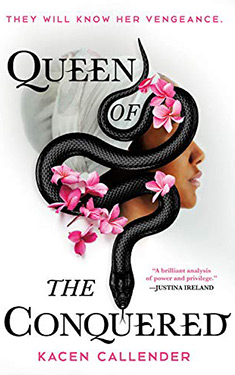Kacen Callender
Completed 4/17/2022, Reviewed 4/17/2022
2 stars
I didn’t care for this book. Only 360 pages and it took me two weeks to get through. Almost the whole book was exposition. The main character could enter people’s minds and practically become them, in effect, getting their back stories. She then proceeded to recount those back stories to us. There was very little action, even though the book is about colonialism, revolt, and revenge. I picked the book up every day and had to force myself to stay awake despite the tedium of the back stories. This book won the 2020 World Fantasy Award.
Sigourney is a black woman on a Caribbean-like nation of many islands dominated by Dutch-like white people from the north. The white people enslaved the native black people. One black family was able to buy its way to freedom. They were able to rise out of poverty and become part of the ruling class. The Rose family was hated but tolerated by the rest of the ruling whites until they decided to kill the Roses. Sigourney was the only survivor. She had the kraft, that is, the gift I described above. Using her kraft and her wits, she grew up with one goal, to exterminate her family’s murderers and claim the throne to free her people.
The thing about the kraft is that anyone could have it. It takes many forms: creating illusions, reading people’s minds, blocking mind readers, causing fear. Sigourney’s kraft allows her to occupy another person’s mind and even control their actions. However, the whites believe it is a gift from their gods, not for the savage island natives. So they kill any black person who shows evidence of having the kraft. Sigourney, to her knowledge, is the only adult black person who has the craft.
The prose was actually good. The word choices and descriptions were done well. It was very readable from that perspective. However, the content was tedious. I felt like the main character went on and on about how much she was hated by both the native people and the ruling class. She was seen as a traitor by her own race for being part of the elite and hated for being a savage who had no right to have the either the craft or her position. Callender reiterated this again and again throughout the book.
The characterization was also good. The narration is first person Sigourney. The other characters we learn of mostly through her entering their minds. At first, I thought this was an interesting technique to describe characters and their motivations, but as the story progressed, it became tedious. The book became one exposition after another with only a little bit of movement in between. Nonetheless, all the characters were very well drawn. No one was a cardboard cutout.
I give this book two stars out of five. I can’t believe it won over the superb The Ten Thousand Doors of January. The usually engaging and enraging themes of racism and colonialism failed to help this book. I might say the sum of the parts were greater than whole. Good prose and characterization, but overall, just plain boring. I’ll probably give this author another chance, but it won’t be with the sequel.

No comments:
Post a Comment